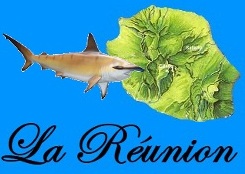Smart Drumlines pass first test in Reunion Island
 Helmut Nickel, Shark Year Magazine,
Helmut Nickel, Shark Year Magazine,23. January 2014
- Smart Drumlines on test in Reunion Island:
- Pilot project regarded as success
- Five sharks caught in two days.
On January 14th, the experimental phase of the fishing project ‘CapRequins’ has been launched in Reunion Island.
This project is coordinated by the local Regional Committee for Maritime Fisheries and Aquaculture ( CRPMEM ) in partnership with the KwaZulu Natal Shark Board ( KZNSB in South Africa ), the Reunion Shark Prevention Association ( PRR ), the Surf League and l’Association Squal’idées.
One of the objectives of this pilot phase, which will run for six months, is to test the effectiveness of an innovative and unique version of drumline.
A drumline is usually defined as an aquatic device consisting of an anchored buoy (originally a drum) from which a single baited hook is suspended. But the new drumlines in Reunion Island are different and regarded as ‘smart’ or ‘intelligent’, because they are additionally equipped with GPS, underwater cameras and sensors that raise an alert signal if a shark gets hooked. In case of a catch, the obtained information will be sent directly to the coordinator who will be able to intervene within 2 hours. The aim of this system is to reduce unnecessary shark mortality, because harmless species or bull and tiger sharks under 1.5 metres in length should be tagged and released. Only larger specimens of these two potentially dangerous shark species may be killed and taken for Reunion’s Ciguatera Program. We already reported about the Ciguatera Program in one of our previous articles ( see Reunion Island plans to kill 90 sharks for Science ).
So last week, four smart drumlines were set near the river mouth in the waters of Saint-Paul Bay. After the testing phase of six months and in case of positive results, the use of these smart fishing-devices shall be extended to other areas off the island’s northwestern coast, like Roches Noires and Boucan Canot.
According to local media reports, the first week of the CapRequins Project has turned out to be very encouraging. Because the smart drumlines already hooked several large specimens of three elasmobrach species and one bony fish species. All shark catches occurred within 48 hours ( Jan 20-22 ). The catches also included two male tiger sharks which were seen as a potential threat to swimmers and surfers. So both specimens were killed and then forwarded for examination to the scientific program to re-evaluate the health risks regarding Ciguatera poisoning.
List of catches made by four ‘Smart Drumlines’
in the bay of Saint-Paul, Reunion Island ( from January 14th to January 22nd ) :
Time of alert : January 16th , 9:40 hrs.
Species: Giant trevally (Caranx ignobilis) .
Size: 36 kg
Action taken: caught alive, but kept for scientific analysis.
Time of alert: January 20th, 23:44 hrs.
Species: Tiger shark, male ( Galeocerdo cuvier ).
Size: 3.19 metres in length and 186 kg in weight.
Action taken: caught alive, but killed for the ‘Ciguatera 2’ Program.
Time of alert: January 21st , 20:58 hrs.
Species: Tiger shark, male ( Galeocerdo cuvier ).
Size: 3.53 metres in length and estimated 360 kg in weight.
Action taken: caught alive, but then killed for the ‘Ciguatera 2’ Program.
Time of alert: January 22nd, 0:09 hrs.
Species: Hammerhead shark, male (Sphyrna sp.)
Size: 2.50 metres in length and ca. 100 kg in weight.
Action taken: caught alive, then tagged (with spaghetti tag) and released.
Time of alert: January 22nd, 19:49 hrs.
Species: Hammerhead shark, male ( Sphyrna sp. )
Size: about 3 metres in length.
Action taken: found dead ( despite intervention within two hours after receiving the alert). Tissue samples taken for scientific analysis.
Time of alert: January 22nd, 20:25 hrs.
Species: Tawny nurse shark, male (Nebrius ferrugineus)
Size: 3.05 metres in length.
Action taken: caught alive, tagged (with spaghetti tag) and released.
But the ‘smart drumlines’ are only one part of the ‘CapRequins’ Project and supposed to catch sharks in a relatively short distance from the shore . As an additional measure, longlines ( reportedly with 300 to 400 hooks ) have been installed in offshore waters of Saint-Paul Bay.
A video of the deployment of the ‘Smart Drumlines’ in Reunion Island can be seen HERE.
–

I am confused.
They installed 300-400 hook long lines of shore (less than a mile from the shore ??)
Whatever species that is able pass through the longlines are hooked by Smart Drumlines for fishermen to kill or release. We call this a success because ???
We can catch the escaped species of any kind of fish from long lines which kills everything without any differentiation ?
And we call this a scientific method ???
I think they call this trying to open the ocean to human use, remember their oceans have been closed for 9 months or so.